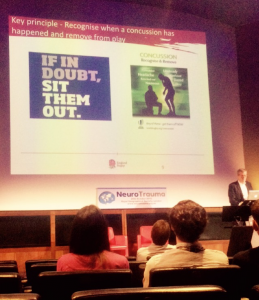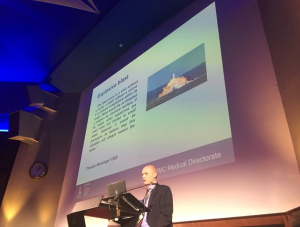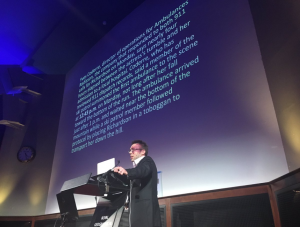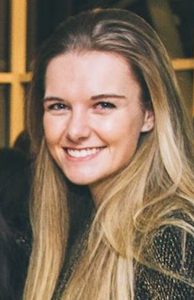On 20th October 2016, leading experts from a wide range of specialties met at the Royal Geographic Society in London for the annual UK Neurotrauma Symposium. As the HYMS Student Blog reporter for the event, I was lucky enough to be joining them. A day filled with fascinating talks, poster presentations, and some fairly gruesome videos awaited.
Concussion in sport
For me, the most anticipated talk of the day was from Dr Simon Kemp, Head of Sports Medicine for Rugby Football Union. Rugby has come under significant media attention recently regarding the risk of players suffering concussion, brain injury caused by trauma. Dr Kemp has worked with leading experts in trying to protect players and the sport from the effects of concussion. Interestingly, he began his talk by reviewing some of the research surrounding concussion in rugby, noting that the incidence in reported cases has greatly increased since 2012. However, is that because rugby has become a more dangerous sport, with players suffering more concussions, or because greater awareness has led to more diagnoses? The common consensus among professionals is that a lower diagnostic threshold is responsible for the rise.
 A key feature of Dr Kemp’s talk was the importance of timely triage for the player on the pitch. There has been a recent shift in methods used to detect concussion, with sports medics now using an assessment tool called the Sport Concussion Assessment Tool, 3rd edition (SCAT-3). This means that, alongside video analysis, quick decisions can be made based on a player’s current SCAT-3 scores, compared to those measured when injury-free.
A key feature of Dr Kemp’s talk was the importance of timely triage for the player on the pitch. There has been a recent shift in methods used to detect concussion, with sports medics now using an assessment tool called the Sport Concussion Assessment Tool, 3rd edition (SCAT-3). This means that, alongside video analysis, quick decisions can be made based on a player’s current SCAT-3 scores, compared to those measured when injury-free.
Medics have previously been criticised by coaches, managers and even players over their demands for removal from play. However, with statistics showing that the risk of sustaining another injury (of any kind) increases by over 60% post-concussion, with long-lasting minor brain damage possible, it is important to correctly identify those who need to be removed from play for both their immediate and long-term health. Dr Kemp ended with a simple, key message: “Recognise, Remove, Recover, Return”.
Blast traumatic brain injury in the military
Lt Col Stuart Harrisson, an Army medic specialising in neurosurgery, drew a lot of interest from the audience for his talk. I was excited to learn about the challenges of dealing with traumatic brain injuries in the expanse of a warzone, with limited access to the equipment and surgical procedures we take for granted in the UK. A slow-motion film of an explosion helped to explain the different blast injuries possible, coming from the primary, secondary and tertiary parts of the blast and involving many different mechanisms. It was interesting, and unsettling, to see just how extensive injuries from blasts can be.
 Something that Lt Col Harrisson was very proud of was the reported year on year improvement in Iraq (Camp Bastian). With each year, the medical care in the camp became more advanced and they were able to access increasingly modern treatments. Responsible for these improvements were a number of factors including better training, more rapidly stopping haemorrhages, and transitioning patients to UK hospitals quickly.
Something that Lt Col Harrisson was very proud of was the reported year on year improvement in Iraq (Camp Bastian). With each year, the medical care in the camp became more advanced and they were able to access increasingly modern treatments. Responsible for these improvements were a number of factors including better training, more rapidly stopping haemorrhages, and transitioning patients to UK hospitals quickly.
A curious phenomenon known as “the Walker dip” was particularly noteworthy. This concept was described by Dr Alasdair Walker, Surgeon-General of the British Armed Forces after poor medical care during the Crimean War. Dr Walker emphasised the importance of maintaining skill level – unless skills are maintained, they are forgotten. This phenomenon explains the all too common decrease in skill levels when moving from one conflict to another, where skills that have been built up are subsequently lost and have to be re-learnt – a fascinating although problematic outcome that can be traced throughout all major conflicts in history. A key issue is whether these skills can be practiced and maintain during “peace-time routine”.
Time-critical neurosurgery
Mr Chris Uff, Consultant Neurosurgeon at the Royal London Hospital, delivered a very interesting talk on the importance of time in severe cases of traumatic brain injury. He opened by talking about the death of actress Natasha Richardson following a skiing accident in Canada. The resulting epidural haematoma was fatal and the slow speed of transfer was highlighted as a significant contributor to her death. Chris talked extensively about the importance of speeding up the time taken to get a critically ill patient from incident into surgery.
 The introduction of Major Trauma Centres across the UK, utilising consultant led teams 24/7 has helped to identify those most in need of specialist help and access surgery rapidly. However, as part of his talk Chris showed a self-made video, timing the journey that many trauma patients make in the Royal London Hospital, travelling from ambulance, to resus, to surgery. As well as being very amusing and highlighting some problematic design flaws in the hospital (such as the significant distance to the surgical floor), this also emphasised how much time was being wasted.
The introduction of Major Trauma Centres across the UK, utilising consultant led teams 24/7 has helped to identify those most in need of specialist help and access surgery rapidly. However, as part of his talk Chris showed a self-made video, timing the journey that many trauma patients make in the Royal London Hospital, travelling from ambulance, to resus, to surgery. As well as being very amusing and highlighting some problematic design flaws in the hospital (such as the significant distance to the surgical floor), this also emphasised how much time was being wasted.
The “code black” trauma call is currently used in the Royal London for the most serious neurotrauma patients where severe head injuries are suspected in patients who do not trigger the “code red” trauma call (used for major haemorrhage). Code black can only be activated by a consultant. This protocol now saves around 50 minutes and involves pre-alerting the neurosurgical and radiology teams and the Emergency theatre. Other time saving procedures are currently being developed including Pre-Hospital Cranial Access and infrascanning to detect potentially life-threatening head injuries. These exciting new developments may result in even faster transfer times and potentially save the lives of many who are involved in serious trauma.
I had a fantastic day at Neurotrauma 2016, meeting amazing people and listening to a great variety of talks. Anyone with an inkling of interest in neurosurgery and traumatic brain injury should consider attending next year – you won’t be disappointed!
Thank you to everyone involved in the organisation of this year’s event, most notably Mr Mark Wilson for an exceptional conference. And a big thanks to Alex Abel and the HYMS student blog team for organising the opportunity.
 Rebecca Walker is a third year medical student at HYMS and a Human Bioscience graduate from the University of Exeter. In her spare time she likes running, skiing and posting pictures of her new puppy on Instagram.
Rebecca Walker is a third year medical student at HYMS and a Human Bioscience graduate from the University of Exeter. In her spare time she likes running, skiing and posting pictures of her new puppy on Instagram.

